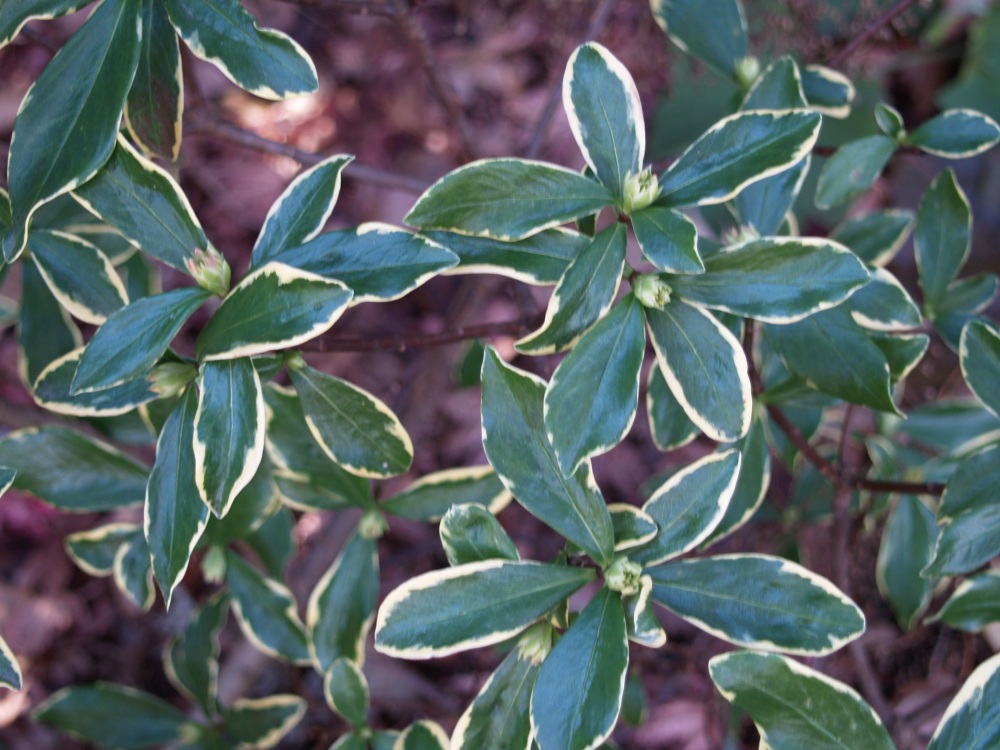After a three week hiatus when nighttime temperatures dropped into the twenties, and then the teens, ‘Eternal Fragrance’ daphne (Daphne x transatlantica ‘Blafra’, below) shows signs that it will flower again in December. Until this year I had experience only with the spring blooming ‘Carol Mackie’ (Daphne × burkwoodii ‘Carol Mackie’) and the variegated cultivar of Winter daphne (Daphne odora ‘Marginata’), so I’ve been more than pleased that ‘Eternal Fragrance’ has flowered continuously since mid spring until the second week of November.

Certainly, only the initial flowering covered the shrub, but in the months since there have been at least a handful of small blooms at all times. Unless temperatures take a turn for the colder, there will probably be another handful later in the week. References promise that ‘Eternal Fragrance’ is the most fragrant of daphnes, but unfortunately my olfactory organs do not function properly so I cannot confirm this.
If there is any fault with ‘Eternal Fragrance’, the green foliage is rather dull, but this is no reason to complain. The long season of flowering has sparked my interest in planting the similarly long blooming, variegated ‘Summer Ice’ (Daphne × transatlantica ‘Summer Ice’) if a shrub of good size can be found.

The variegated Winter daphne (above) has fully recovered, it seems, from damage done last winter. All foliage and flower buds were lost, though stems showed live buds so that its survival was never too questionable. A few dead branch tips required minor pruning, but by late spring there was no sign of the winter injury, and in mid December flower buds have been set as is typical.

‘Carol Mackie’ (above) suffered little and perhaps no damage after the winter, though I must report that I was so discouraged after the severe winter that I was overjoyed that any shrubs leafed and flowered in the spring. I can barely recall that ‘Carol Mackie’ was a bit tardy, but so was everything else.
I cannot confirm that daphnes are difficult and short lived since I have sensibly refrained from transplanting any against the common advice that they are not easily moved. ‘Carol Mackie’ has survived severe trauma from large limbs falling from overhanging swamp maples, though today, instead of its typical rounded form, stems fork is opposite directions with a lush sweetshrub filling the space between. No one would know if I didn’t tell, but perhaps this daphne is not as finicky as others.

On two occasions the small leafed Rose daphne (Daphne cneorum, above) has failed to survive upon planting, though I suspect the latest failure resulted from damage to roots when I attempted to remove the heavy soil from the pot when planting. The ball of earth fell apart, which I supposed would be a problem. After the first dry period in late spring, both small shrubs were dead. Since daphnes are often potted from the field rather than grown in a container with a light soil mix, I advise cutting the container to remove the roots for planting rather than attempting to slide the heavy soil rootball out of the container.
Otherwise, I’ve had excellent luck with daphnes, and I’m encouraged to plant others since they require little except careful planting and proper siting in well drained soil. I’ve seem slight variations in the abundance of blooms from one section of the garden to another, but I haven’t been able to tell for certain which area has more or less shade. I suspect that some shade to protect from the afternoon sun is the best formula to encourage flowering, but all daphnes with varying degrees of light shade have performed satisfactorily.